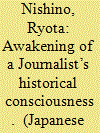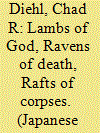|
|
|
Sort Order |
|
|
|
Items / Page
|
|
|
|
|
|
|
| Srl | Item |
| 1 |
ID:
152850


|
|
|
|
|
| Summary/Abstract |
Between 2005 and 2006 a female journalist Sasa Yukie (b. 1974) participated in and documented the commemoration of Japanese soldiers who died in the Pacific Islands during the Pacific War with other veterans and the families of deceased soldiers. Sasa’s book, Onna hitori gyokusai no shima o yuku (2007), integrates her travel experience, impressions of her fellow travellers, historical accounts, and reflections on battlefields and commemoration sites. This article charts the two-stage process of Sasa’s emerging historical consciousness in this travelogue. The first phase involves her growing empathy with her fellow tour members. Sasa follows a well-established Japanese literary trope that exalts the protagonists’ loss to a noble cause. Thus, Sasa turns tour members and dead soldiers into tragic yet honourable heroes on her terms rather than theirs. The second phase involves Sasa’s transformation into a passionate advocate for the greater recognition of and respect for deceased soldiers, veterans, and bereaved families. This article is a critical reading of this text, and argues that her travel experience was an impetus for Sasa’s nationalistic tendencies. Her reduction of the memories of war and Islanders into metaphors of hōganbiiki discourages questions about the responsibilities and suffering of those involved and implicated in the war. I argue that this book is significant because it enabled Sasa to carve a particular journalistic niche as a journalist-activist promoting the interests of Pacific War veterans.
|
|
|
|
|
|
|
|
|
|
|
|
|
|
|
|
| 2 |
ID:
152849


|
|
|
|
|
| Summary/Abstract |
In 2014, ASTIGU – a Japanese pantyhose brand – launched ‘ashi wa, kao’ (legs are face), a new series of advertisements featuring a female model whose face is painted black. Although scholars have previously written on blackface and blackness in Japan, they have focused more on subcultural contexts and men’s instead of women’s experiences. Drawing on the campaign’s promotional materials and employing women’s blackface practices as a heuristic device, this essay tracks constructions of blackness and femininity in Japanese advertising. I argue that Japanese women’s wearing of blackface forms affective spaces for consumers to negotiate their racial, gender, and national identities. While ‘Japaneseness’ and femininity are initially based on the bihaku (beautiful white) model, the idea of black masks alters women’s relationships to their bodies and allows them to experiment with racial otherness and alternative femininities. By unsettling notions of race, gender, and nation in Japanese society, I suggest that the dual commodification of bihaku and blackface in these advertisements potentially generates transnational forms of femininity. Building on scholarship on race, affect, femininity, and Japanese mass culture, this essay ultimately investigates how consuming women in blackface traverses gender and racial constructions in Japan, contributing to transnational flows of consumer culture.
|
|
|
|
|
|
|
|
|
|
|
|
|
|
|
|
| 3 |
ID:
152847


|
|
|
|
|
| Summary/Abstract |
Drawing on social constructionist theory and critical discourse analysis in media studies, this article examines the portrayal of female entrepreneurs in the Japanese business press over a 25-year period from 1990 to 2014. We find that, despite the increased variety in the representations of female entrepreneurs, traditionally gendered discourses prevail in positioning women as inferior in the entrepreneurship discourse specifically, and in the social order at large. This positioning of female entrepreneurs is achieved by stereotypical representations, drawing on traditionally gendered ‘division of labour’ and ‘women and men are different’ frames, and is masked by seemingly feminist and progressive ‘work–life balance’ and ‘entrepreneurship as self-realization’ representations. Our findings resonate with those of other research in Western contexts and confirm the male-gendered nature of entrepreneurship in Japan. The discourses uncovered appear to be hinged on evaluative assumptions about the social world and women’s position within it and are reflective of and at the same time reify Japan’s capitalist male-dominated ideology. Moreover, as these portrayals shape societal attitudes, which are assumed to affect entrepreneurship levels, this lack of progress in the media discourse is likely to negatively affect female entrepreneurship levels.
|
|
|
|
|
|
|
|
|
|
|
|
|
|
|
|
| 4 |
ID:
152851


|
|
|
|
|
| Summary/Abstract |
The recent discovery of a personal photograph album belonging to Ichiro Kagiyama offers new insight into this notable photographer’s work, biography and the Australian-Japanese community in Sydney in the 1910s. As a Japanese resident of Sydney from the early to mid-twentieth century, where he was an active member of the Photographic Society of New South Wales, a regular contributor to The Home magazine and a professional photographer operating his own commercial studio, Kagiyama made a valuable contribution to Australian visual culture. Regrettably very few examples of Kagiyama’s photographs are known to survive today. The rare personal album of 154 photographs examined here for the first time begins to address this paucity of material. This album presents images of important public moments of inter-cultural encounter between Australia and Japan, and reveals how Kagiyama used photography as an interpretive instrument to negotiate his own place amongst Anglo- and Japanese-Australian communities. The album also includes family photographs from Japan and hometown souvenirs, thus underscoring the mobility of photographs as material objects that can bridge the geographical and cultural distance between Australia and Japan.
|
|
|
|
|
|
|
|
|
|
|
|
|
|
|
|
| 5 |
ID:
152852


|
|
|
|
|
| Summary/Abstract |
This article explores the poetry written by survivors of the atomic bombing of Nagasaki to elucidate the history of atomic memory in the city. Looking closely at works by three poets, the article discusses how poetry served as a medium for the survivors to grapple with traumatic memory and convey the atomic experience in meaningful ways that both provided catharsis and challenged a landscape of memory that ignored their personal trauma and suffering. An analysis of their verse also informs our understanding of the historical nature of war trauma more generally.
|
|
|
|
|
|
|
|
|
|
|
|
|
|
|
|
| 6 |
ID:
152848


|
|
|
|
|
| Summary/Abstract |
This article explores representations of whiteness in contemporary Japanese culture. Specifically, I argue that although representations of caucasian whiteness pervade Japanese media and popular culture, they have largely remained racially unmarked, scholarly and popular discourse presenting caucasian whiteness in cultural not racial termes, where it finds expression in notions of an idealized, fetishized, cosmopolitan westernness. As a result, the discourse of whiteness in Japan has largely escaped the kind of sustained critical commentary in Japan and the United States that characterizes the discourse of blackness and other explicitly racially marked Others as well as the literature on whiteness studies, which has yet to fully engage constructions of whiteness outside the (post)colonial experience and the Euro-Americocentric black/white binary. I discuss how representations of whiteness provide a template through which Japanese reflexively construct both the foreign White Other and the ‘white’ Japanese Self, the evaluation of these selves often being ambiguous and conflicted. I conclude that as Japan’s exposure to whites and non-whites increases and as its own internal diversity becomes more visibly salient, Japanese have begun to contest and more critically interrogate (re)presentations of themselves and to renegotiate their place within given racial and aesthetic hierarchies.
|
|
|
|
|
|
|
|
|
|
|
|
|
|
|
|
|
|
|
|
|